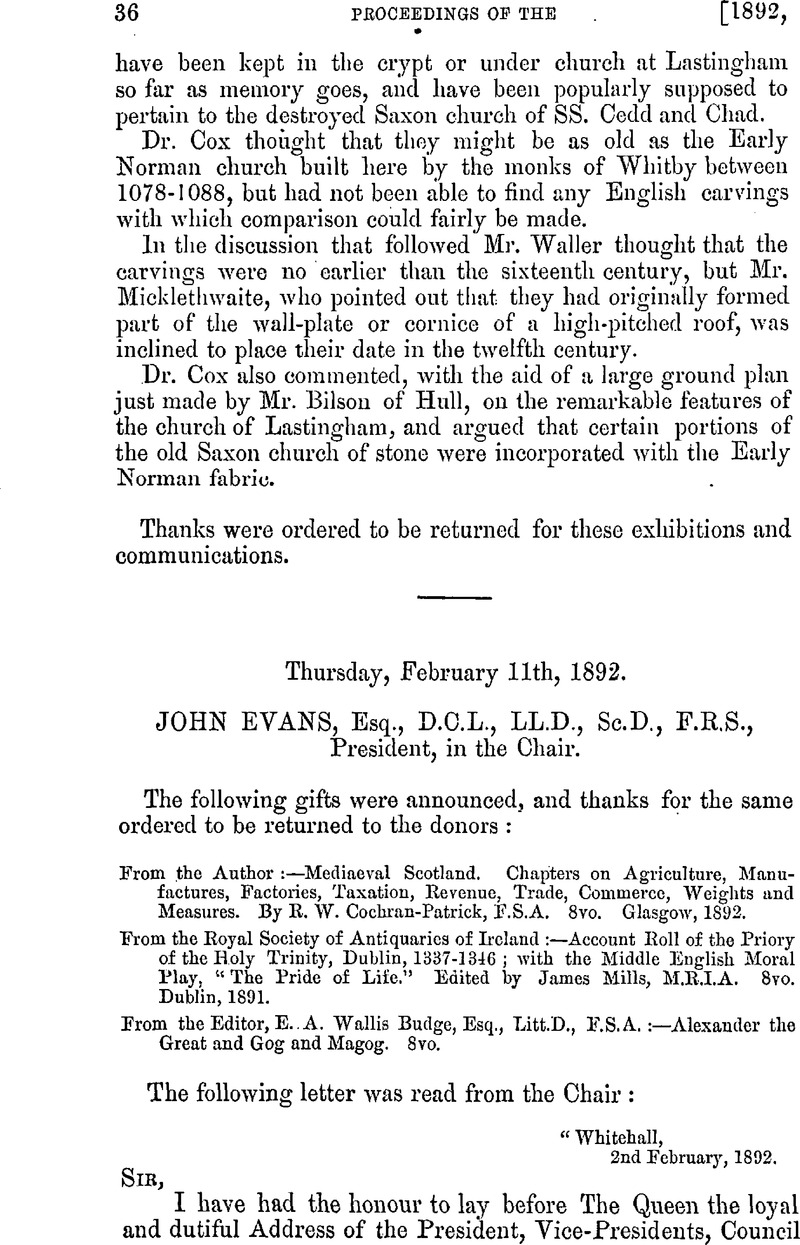Published online by Cambridge University Press: 10 May 2010

page 40 note * See Henderson's, Folk-Lore of Northern Counties, London, 1866, p. 205Google Scholar ; Thorpe's Mythology, vol. iii. pp. 274, 275.
page 43 note * Proc. S. A., 2d S. xiii. 83.
page 43 note † Ibid. xiii. 98.
page 43 note ‡ This chimney is well shown in Transactions of the Cumberland and West morland Antiquarian and Archæological Society, ii. pl. i. opposite to p. 72.
page 45 note * I was much struck by this three years ago in preparing my Relief Map of Syracuse, and I have been more struck since, while reading impressions of the ground communicated to me by scholars who have visited the site lately.
page 45 note † C. I. L. vii. 241 (A.D. 109); Ephem. vii. 943. A tile found at Carlisle may mention the ninth legion, destroyed in Hadrian's reign, but it is imperfect. Dr. Hübner's supplement of C. 1349 is pure conjecture.
page 46 note * The stone has Hadriani, but the genitive is very rare ; and, as the letters have been recut, a modern mistake is probable.
page 47 note * We ought possibly to add to this list C.I.L. vii. 961 (Lap. Sept. 770) usually ascribed to Netherby. The inscription, which is very like those quoted above, was first noticed in the wall of a house. But a Bewcastle stone (if Dr. Hübner is right in referring it to Hadrian) also mentions Hadrian's forts north of the wall (C.I.L. vii. 978).
page 48 note * The often quoted passage in Tacitus, Agricola, 20, does not prove this, because Tacitus explicitly says that the forts noticed in that passage were erected within the area already conquered by previous governors (Agr., 22), and it is pretty certain that the Roman generals had not annexed Durham and Cumberland before A.D. 80.
page 49 note * C. I. L. vii. 620a. I omit also the milestones along the via vallaris. See Note to p. 54.
page 49 note † C. I. L. vii. 748.
page 50 note * Halton Chesters, C. I. L. vii. 563; Birdoswald, 802; Bankshead, 836; Carrawburgh, 1347; Cheaters, 584, and Ephem. vii. 1019.
page 50 note † Benwell, C. I. L. vii. 503, 504 ; Melkrigg, 758 ; Carvoran, 773, 774 ; Great Chesters, 731.
page 51 note * Probably Alfenio was on the stone, which is now lost, the I being placed on top of the N. For the date of his governorship see Liebenam, Verwaltungsgeschichte, p. 109.
page 51 note † Fuchs, Geschichte dcs Severus, p. 119.
page 51 note ‡ C.I.L. vii. 269.
page 52 note * The theory that they were hung round recruits' necks, as suggested by Mr. Coote, H. C. (Trans. London, and Middlesex Arch. Soc. (1873), iv. 50)Google Scholar, does not, I think, need refutation. I have quoted in the Archaeological Journal, xlvii. 264, some similar lead seals found abroad which are almost certainly baggage labels for customs purposes.
page 53 note * Housesteads, C. I. L. vii. 664; South Shields, 490 ; Birdoswald, 818.
page 53 note † Chesters C. I. L. vii 585; Greatchesters, 732 ; Chesterholm, 715 ; Chesters (Xenephon), Ephem. vii. 1021 ; Housesteads, Ephem. vii. 1041.
page 54 note * There are also three milestones in North Wales, Leicester, Lancaster. I have omitted the milestones of the via vallaris from my lists, because the date of the stone wall cannot be proved from them. Milestones are, further, bad subjects for argument. It was common to erect a new milestone for a new emperor, and the new stone was often obtained by cleaning an old one. Hence early milestones are not common.
page 54 note † British inscriptions with this formula seem to belong mostly to the end of the second or beginning of the third century. The formula itself corresponds, if not in meaning, at least in use, to the Rhenish in honorem domus divinue, and does not appear to imply two emperors reigning at the date of its use. See Mommsen, Hermes, xix. 232, n. 3.
page 54 note † See Mommsen, Römische Geschichte, v. 170, n.
page 54 note § Mommsen, R. G. v. 170, on other considerations than that urged above.
page 55 note * C. I. L. vii. 940, Lap. Sept. 508.
page 55 note † The Fairford Windows, a monograph by the Rev. James Gerald Joyce, B. A., F.S.A., Arundel Society, 1872, p. 109.
page 56 note * Charlemagne has a feast day (January 28) allotted to him in the French and German calendars, but not in the Roman, nor in any old national calendars other than those mentioned.
page 56 note † Vol. xlix. 243–300.
page 57 note * There is one slight reason, which Mr. Joyce does not mention, for supposing St. Edmund may be intended. John Tame's son was Sir Edmund Tame, and he may therefore have had some veneration for that saint.